Compared to the HackPro.
When FU Steve built the HackPro to replace my fried 24″ iMac the goal was simple – make something reliable and fast for photo processing with superior heat management and using inexpensive off-the-shelf parts.
Technology marches on and Apple has now released its latest iMac which in its best configuration includes the latest Intel i7 CPU and a 27″ display. Is it better than the HackPro?
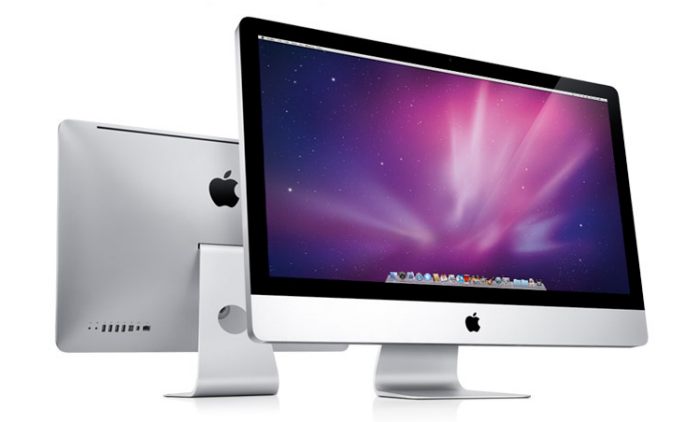
Summer 2010 27″ iMac.
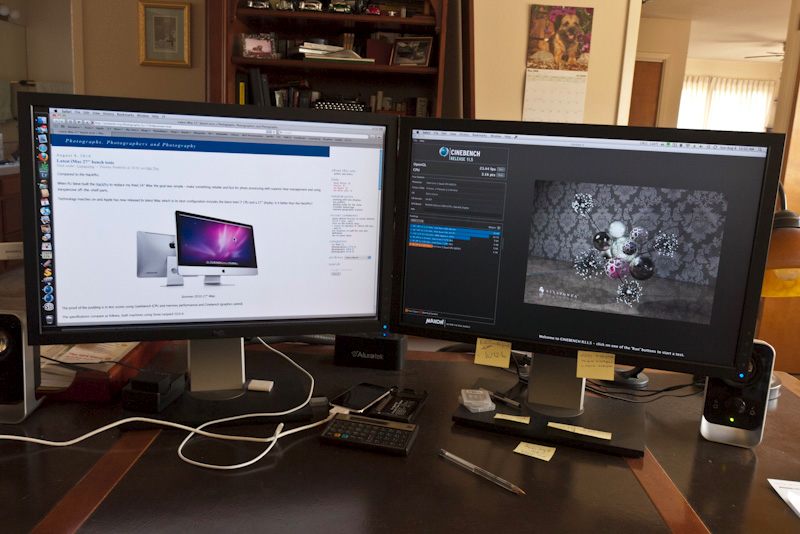
HackPro (under the desk!) running two Dell 2209WA monitors, fall 2009 vintage.
The proof of the pudding is in test scores using Geekbench (CPU and memory performance) and Cinebench (video and graphics speed).
The specifications compare as follows, both machines using Snow Leopard 10.6.4:
HackPro:
CPU: 2.83gHz Intel Core2Quad, Q9550
GPU: EVGA Nvidia 9800GTX+ with 512mB GDDR3 memory
RAM: 8gB DDR2 800mHz
iMac 27″ i7:
CPU: 2.93gHz Intel QuadCore i7
GPU: ATI Radeon HD5750 with 1gB GDDR5 memory
RAM: 8gB DDR3 1333mHz
Here are the test results using Geekbench and Cinebench, both in 64-bit mode:
Geekbench 2.1.6 64-bit:
HackPro (my tests):
Overall: 6731
Integer: 6430
Floating point: 10142
Memory: 3385
STREAM: 2545
iMac (Apple Insider tests):
Overall: 10052
Integer: 8868
Floating point: 15764
Memory: 5028
STREAM: 4258
Cinebench 11.5 64-bit:
HackPro (my tests):
OpenGL: 23.44 fps
CPU: 3.16 pts
iMac (Bare Feats tests):
OpenGL: Not stated, but I would guess 20-30% faster
CPU: 5.50 pts
What’s the fastest that Cinebench has tested? Here are the results from their database (12C/12T means 12 Cores and 12 Threads):
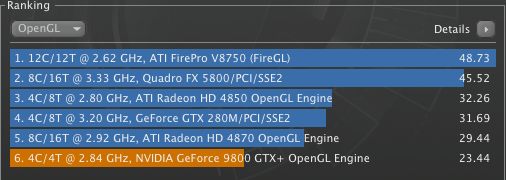
Cinebench R11 OpenGL test results – HackPro in orange.
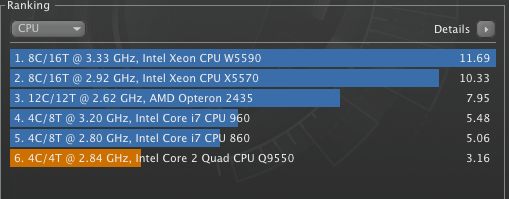
Cinebench R11 CPU test results – HackPro in orange.
The bottom line is that the top of the line iMac i7 CPU model smokes the HackPro with faster video, CPU and RAM performance. The price is competitive too. The top of the line iMac i7 with 8gB RAM sells for $2,399. The HackPro with a like screen (the Dell U2711), CPU, GPU and RAM would cost $2,000 to make.
So what’s to choose?
- The iMac is $400 more
- The iMac needs zero construction time. It takes an experienced worker 3-4 hours to assemble the HackPro, and klutzes need not apply
- The iMac uses an LG 2560 x 1440 IPS display with a glossy glass cover; the screen only accommodates 72% of the AdobeRGB gamut. 1 year warranty.
- The Dell U2711 uses the same LG display with a matte plastic cover; the screen accommodates 96% of the AdobeRGB gamut. 3 year warranty.
- Reliability of the iMac is unknown.
So the iMac is a good buy if you can get over the unanswered reliability issue and think you can properly profile that garish screen with the very limited adjustments provided. My experience is that Apple makes some of the most unreliable hardware on earth, with heat managment consistently compromised at the altar of appearance. However, if this new iMac proves reliable then it’s getting very hard to justify the 100% premium asked for the separate box MacPro.
There’s no arguing with the value this time around. Further, if you want a second 27″ display, Apple’s newly announced (glossy, of course) Cinema Display will run you $1,000, which is much the same that Dell is charging for its comparable Ultrasharp 2711.
Am I tempted to upgrade? Not remotely. While I can increase the HackPro’s CPU performance by 20% by simply overclocking the CPU there is no incentive to do so, given my needs. The enhanced speed means little to me as my primary use is Lightroom 3 (where everything is super fast on my rig) and I do no video processing; were I doing the latter for a living I would certainly think about it, if I could get comfortable with the glossy screen and its poor handling of the Adobe RGB gamut. The most likely upgrade in my future is to a pair of larger Dell monitors – either the 24″ U2410 ($500 each) or the 27″ U2711 ($1,000). But that’s a discussion for another day. Stated differently, for my use the HackPro’s processing speed is at the point of diminishing returns, meaning I would have to spend a lot more for a relatively modest increase; the graphics display card remains state-of-the art and can drive anything out there but there are now considerably better and larger displays available, albeit at a price. Indeed, for my day job of money management, which uses lots of stock price, bond yield and live news data feeds, the only thing I would like in the HackPro is more screen real estate. It seems there’s never enough display space available in our information overloaded world.
As a matter of interest, as the HackPro is assembled from readily available off-the-shelf PC components, upgrading to the CPU and RAM specifications of the latest top-of-the-line iMac would necessitate a new motherboard, CPU and RAM at at total cost of $700. The GPU in the iMac is close in specs to that in the HackPro so no upgrade is called for. Everything else in the HackPro – case, coolers, drives, card reader, wireless, can be reused. Not something you can say of the iMac. And given that most of the HackPro’s components come with 3-5 year warranties, a fairer price comparison suggests adding AppleCare at $169 to the cost of the iMac which extends the one year warranty to three years.
How cool does the HackPro run with its five fans (two set on medium – case cooler and HDD cooler, three variable speed – CPU, GPU and power supply coolers)?
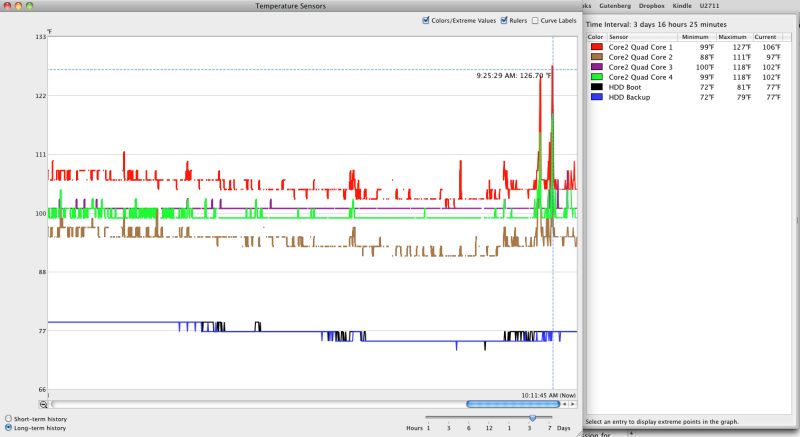
The spikes are from running the demanding Cinebench video benchmarks.
Sure would be nice to have that data for the new iMac; when running Lightroom the temperatures barely budge on the HackPro.
If you are spending someone else’s money, not your own, here are the latest MacPro prices, all without a monitor:

Prices for dopes.